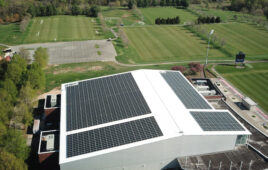Just a few days after President Biden’s Department of Energy released a first-ever blueprint calling for an immediate doubling of solar energy to fight climate change, Sacramento’s local utility company adopted a policy that will slow down new solar installations in the region while harming existing solar users. The policy comes a year after the Sacramento Municipal Utility District (SMUD) Board of Directors adopted its own climate emergency declaration and committed itself to getting off fossil fuels by 2030. That commitment will require a lot more renewable energy, yet neither the SMUD Board nor its staff have a plan for how it will get there, leaving environmentalists dumbstruck as they watch the utility deliberately slow down the growth of solar energy in the region.
“SMUD is killing rooftop solar at a time when they should be doing everything in their power to grow it,” said Lee Miller, Elk Grove resident and board member of the Solar Rights Alliance, an organization that represents solar users in the Sacramento region and across California. “This is utter madness. The state is burning. Hurricanes are raging. We need more solar, a hell of a lot more solar power, and we need it right now.”
In response to SMUD’s decision to slash solar incentives, solar users and environmentalists took to the streets, organizing a protest outside SMUD headquarters during a virtual board meeting.
“I went solar to help the planet, power my EV, and save money on my utility bill, but I never thought SMUD would claw back the financial benefits of significant customer investments in clean, renewable, energy,” said SMUD customer Fatima Malik. “SMUD used to be a progressive utility, but they have become a backwoods bully. All they seem to care about is hoarding opportunities and monopolizing the solar energy market.”
At a board meeting Thursday night, the SMUD Board of Directors voted to adopt changes to its long-standing net-metering program. Under net metering, 36,000 SMUD homes have gone solar to date, including 2,000 low-income families on SMUD’s bill assistance program, and more than 400 businesses.
Specifically, starting March 2022, SMUD will reduce the credit customers receive for energy sent back to the grid and used within their immediate neighborhood by 44%, from 13.2 cents to 7.4 cents per kilowatt-hour. Such a move will make solar investments less valuable and therefore harm the financial benefits. Most consumers look to save money by investing in solar power. The policy changes will be retroactive to all existing solar users in SMUD territory starting in 2031. The reduced credits are also triggered by adding solar panels to an existing solar system, adding a battery, or selling your home. Making retroactive changes to net metering is something the state of California has rejected for customers of PG&E.
Today, 6,400 homes in Sacramento County invest in solar every year, generating 27 MW of clean energy and supporting 2,700 jobs and dozens of local businesses. The California Solar and Storage Association estimates that under SMUD’s new program, the solar market for existing homes will slow down and reduce by as much as 40-50 percent from what it is today.
“We’ve seen this movie before. Other utilities have tried the same thing and the results are disastrous: less solar and fewer local jobs,” said Ben Davis, policy associate at the California Solar & Storage Association (CALSSA) representing dozens of local solar companies and their workers. “We see this kind of backwards policy making in other states, but you never really get used to seeing it in California, not to mention Sacramento. It is a shame.”
At a workshop of the SMUD Board of Directors two weeks ago, SMUD staff orchestrated public comment from local organizations and businesses they lined up to speak in favor of their anti-solar proposal. Many of the organizations receive grant money from SMUD and had little knowledge in the policy being debated. Meanwhile, members of the public, including existing solar users, were expected to wait more than three hours on a video call to testify against the proposal. Many individuals dropped off due to the long wait and feeling of disenfranchisement.
“I can’t believe SMUD is not supporting working families by allowing them to use solar to reduce their bills when we are struggling with COVID and under-unemployment,” said Adriana Santana, a mother of six who lives in Del Paso Heights and went solar last year. “My bill used to be over $400/month, and I was drowning in debt. I was falling behind on my bill payments and was having to sacrifice because if I pay $400 to SMUD, that’s money I don’t have for groceries for two weeks for my kids. I invested in solar to save money and it worked, but now SMUD is trying to pull the rug out from under me and my neighbors.”
In promoting their anti-solar plan, SMUD is touting their support of another program that they claim will spur the adoption of energy storage but is actually a lackluster initiative that raises a number of questions for consumers. Under the program, SMUD would provide an upfront rebate of up to $2,500 plus $200 per year. Combined, the payments will cover approximately 35% of the battery’s cost, but the homeowner would need to turn over 75% of the battery to SMUD for up to 200 days each year. The program is unlikely to spur significant adoption given the high cost of batteries and low subsidy payments combined with requirements that make the battery feel more like SMUD’s than the homeowner’s.
Meanwhile, SMUD is maintaining its large subsidies to consumers who invest in electric appliances and vehicles. The utility prefers homes that are all electric but that don’t have their own solar energy system to cover their increased electricity usage. In this way, consumers buy more of SMUD’s product: electricity, which increases the utility’s revenues significantly.
“We are all about solar energy and energy storage, and rooftop solar goes hand in glove with electrification efforts,” said Davis. “But consumers need solar power to charge their batteries and they need solar power to cover their increased electricity usage. Killing the economics of solar while attempting to encourage batteries and home electrification is like taking one step forward and two steps back. This is how you squash an emerging market, not how you grow it.”
Utility interests, including SMUD, have promoted making major changes to the state’s net-metering program through a trumped-up cost-shift argument. Their line of thinking claims homeowners, schools and businesses who generate their own power from the sun are not providing enough revenue for the utility, thereby forcing the utility to meet their revenue needs on the backs of other customers. Studies show that investing in local rooftop solar energy can save on utility costs, avoiding having to bring energy into cities like Sacramento from distant solar and wind farms. Utility revenues may shrink but their ability to pass along savings to all ratepayers from a more affordable, renewable electric grid grows.
“Everyone knows a stitch in time saves nine,” said Miller. “Investing in rooftop solar energy today, will save all consumers billions of dollars in the years to come as we continue to fight climate change. That’s what President Biden’s call to action is all about and it is a shame the SMUD Board of Directors is going in the opposite direction.”
News item from the Solar Rights Alliance




If people that own a solar systems would have off & on switch 100 AMPS install between the meter and .main panel to simulate a black-out you could cut SMUD out of the most expensive power in the day between 5PM & 8PM. SMUD would make less money and I did just that and have reduced my by bill down to $23.04 per month. I want to pass this along to all who have solar installed on their homes as well solar installers.
I am a SMUD user who installed solar panels in 2019, the same year I purchased a Nissan Leaf. I got grandfathered in under the old system until 2031. I hope by then battery prices come down because my generated KhWs are worth more to me than 7.4 cents each.
What is going on here is that SMUD is taking excess generated electricity from owners, at 7.4 cents then selling to your neighbors for full retail price. They are profiting from your solar! This is a windfall to SMUD from your solar system that they won’t admit. When SMUD credited solar owners the market rate (say 15 cents) and then sold the excess watts to your neighbor at the same price, it basically resulted in $0 for SMUD and lost sales for SMUD because you generated that power for your neighbors instead of SMUD. This was not loss profit, it was loss of revenue for SMUD, lost to homeowners who were in essence energy competitors. SMUD just wiped out the competition. Don’t believe the arguments SMUD made in favor of its 2022 change, it was all about wiping out the excess solar energy competition and guaranteeing that even solar users would now pay SMUD more.
I already ordered a Tesla Solar panel in January 2, 2022, and was waiting for the Permits and paperwork to complete. Now I’ll be cancelling my order. I bet SMUD took their sweet time on approving my system, so that we’ll be put on the new plan. Nice job SMUD, protecting your revenue stream. Bye bye Planet Earth! The greed of corporations is the death of the human race! With all the technology, and people just starting to believe and care about our future, we still can’t save our planet. So sad, and sadder for the next generation who will suffer most!
Great! In my mid 70’s my electricity costs will be going up significantly. I had a robust solar system installed 7 years ago and have never used more power than has been generated by my system. I’ve never complained about the the monthly service fees and recognize we need to pay for the support and maintenance of the SMUD power system. Just like electric car owners need to contribute to the maintenance of our roads perhaps a flat amount per home with solar cloud be considered.
Am i to understand if i contract for solar prior to March 2022 it doesnt really matter because in 2031 SMUD is cutting the amount of credit by 44% anyway, even to those who have had their solarfor years now? So by installing in 2022 eith a January contract signed MY excellent savings is only for 9 years through 2031?.
If they candi this to existing solar customers ow (change their terms), they can do it later as well
Vote all of the anti solar board members out!
We were planning to go fully solar in the next two months. We were willing to put the money in as an investment in the planet, and because we would would have recouped much of our investment.
SMUD just priced us out of solar.
SMUD used to be a good utility company but seems they are feeling the pinch of lower profits. Why doesn’t the PUC deny them the ability to make such drastic changes like they do PG&E?
The PUC is a board of people who own vast a,pints of wealth and stock in the electricity industry. While they are tasked with regulating the market of electricity they do not do so in actuality. The personal incentive to the board member of increased stock price and dividend always wins unfortunately. For example, in the last God knows how long, PG&E has been able to maintain profit margins of 10% every year because they have never been denied a rate increase by th PUC. They apply for rate increase to cover their cost and ensure future stock and dividend growth. This is upheld by PUC board members who are heavily invested in the company. California somehow has 2 of the top 5 electrical rates in the entire country. This is due to the lack of regulation in the market by the governing body who are unfortunately too self interested to do anything for the citizens of this great state.
““I went solar to help the planet, power my EV, and save money on my utility bill, but I never thought SMUD would claw back the financial benefits of significant customer investments in clean, renewable, energy,” said SMUD customer Fatima Malik. “SMUD used to be a progressive utility, but they have become a backwoods bully. All they seem to care about is hoarding opportunities and monopolizing the solar energy market.””
This push to change net metering to net billing is a nationwide battle being fought by the desperate electric utilities. There may be unintended consequences SMUD hasn’t realized yet. This also pushes the 36,000 plus adopters to add energy storage if they haven’t already and service more of their energy needs every day instead of selling at or near wholesale to the utility and buying expensive retail from the utility.
” At a workshop of the SMUD Board of Directors two weeks ago, SMUD staff orchestrated public comment from local organizations and businesses they lined up to speak in favor of their anti-solar proposal. Many of the organizations receive grant money from SMUD and had little knowledge in the policy being debated. Many individuals dropped off due to the long wait and feeling of disenfranchisement.’
Great, the age old practice of “buying votes” or in this case buying complacency and praise by giving out grants.
” Meanwhile, members of the public, including existing solar users, were expected to wait more than three hours on a video call to testify against the proposal.”
Personally I would consider this as a violation of the original intent of the Brown ACT. I would suggest a “proper solution” of having the public heard would be to announce well ahead of time the meeting, use the electric bill mailing or post on the web site where electric bills are paid. IN the meeting announce how many of the public posted for the program and how many posted against the program. Then at the next meeting announce again that the public had (X) comments against the proposal and the public had (Y) comments for the project and reveal the number of participants that received grants, loans or other considerations from SMUD. SMUD like many other utilities talk “transparency” but do not see their own hypocrisy when they are gaming the system.